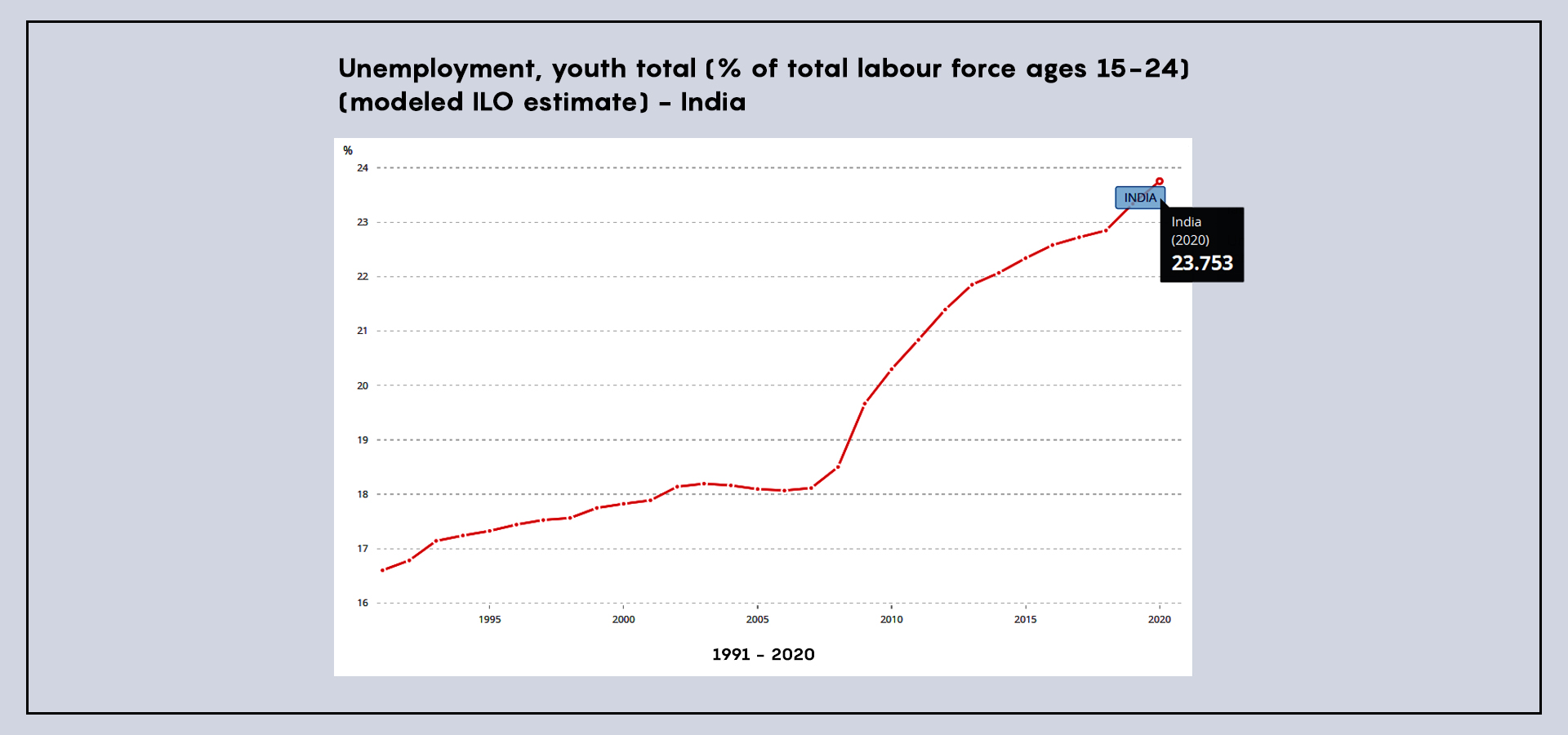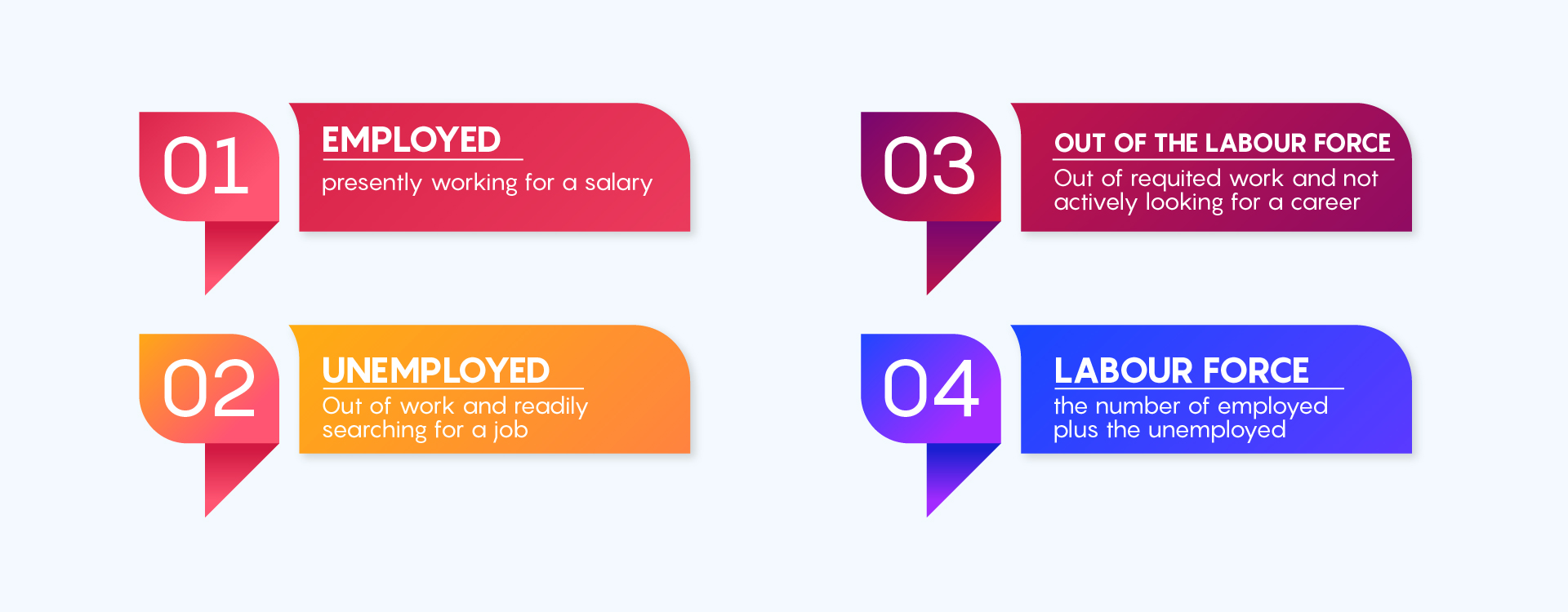As defined by the Organisation for Economic Co-operation and Development (OECD), unemployment is the state of having no earning occupation or self-employment for people usually above 15 years of age, and no revenue source is available to those people.
Unemployment can arise from various transformations and situations, such as:
New technology and innovation,
A recession ruining the economic situation,
Competition on globalisation and international trade,
Government legislation, and
Regulatory practices and laws.
Unemployment is calculated by the unemployment rate, which is the number of unemployed people as a percentage of the labour force.
A country can influence unemployment and the economy’s status through, for example, fiscal policy. Furthermore, a country’s monetary authority, such as the central bank, can influence the availability and cost for money through its monetary policy.
‘‘
There were 172 million people worldwide (or 5% of the reported global workforce) without work in 2018.
- UN's International Labour Organization (ILO)

Classification of unemployment
In addition to unemployment theories, a small number of unemployment classifications have been used to indicate the effects of unemployment in an economic system more accurately. Some of the main categories of unemployment include:
Structural Unemployment
Structural unemployment is a mismatch between workers’ skills or locations and job requirements. It focuses on fundamental economic problems and inefficiencies inherent in labour markets, including mismatches between the supply and demand of skilled workers, disruptive technologies and structural logics highlighting the causes and solutions to globalisation.,
Frictional Unemployment
Frictional unemployment focusses on voluntary work decisions based on the evaluation of employee’s tasks and compares current wage rates to the time and effort required to work.
Cyclical Unemployment
Cyclical, or seasonal, unemployment occurs due to seasonal patterns in economic activity, such as harvesting or tourism.
Involuntary Unemployment
Involuntary unemployment transpires when a person is ready to work at the prevailing wage yet is unemployed. It is distinguished from voluntary unemployment, where workers choose not to work because their reservation wage is higher than the prevailing wage.
Classical Unemployment
Classical unemployment is unemployment resulting from an increase in wages above the free-market equilibrium wage rate.
Unemployment Rate
The unemployment rate is delineated as the share of unemployed workers in the total labour force. Workers are considered unemployed if they are not able to work despite the ability and will to work. The total active population in the economy consists of the working people and the unemployed.
The unemployment rate is the share of the unemployed in the total population. A majority of young people between the ages of 15 and 24 continuously indulge in academic pursuits and therefore not counted towards active working or looking for work population. This means that they are not part of the labour force, which plays a decisive role in calculating the unemployment rate.
Statistically speaking, the youth unemployment rate ranges from 5.2% (Austria) to 20.4% (Spain). They are much lower than the standard youth unemployment rate, ranging from 7.9 (Germany) to 57.9 (Greece).
What’s the significance of the Unemployment rate?
Typically, unemployment rates indicate a lack of economic potential and resources in a nation. Unemployment tends to turn upside down as any economy grows, and companies hire more labour to meet the growing demand. It usually increases due to reduced economic activity.
The methods used to calculate the unemployment rate are often different in each country due to varying employment and unemployment definitions and other data sources.
Who Is Unemployed?
Should everyone who is not working consider themselves unemployed? Of course not. For example, students should not be regarded as unemployed. And retirees should not be counted as unemployed. Many full-time students only have part-time jobs or no job at all, but it seems inappropriate to consider them unemployed. Some people do not work because of unusual situations, like raising sick children or on parental leaves.
The fact is that the adult population can simply not be divided into the binary of employed and unemployed people. There is a large group that includes unemployed people, and for whatever reason, such as pensions, childcare, voluntary termination of employment, they are also not interested in work. It also consists of those who do want a job but have quit looking, often due to being discouraged by finding viable employment. Economists allude to this third group of those who are not working and not looking for work as “out of labour force”.
To be categorised as unemployed, a person must be without a job, currently ready to work, and actively searching for work in the preceding four weeks. Thus, a person who does not have an occupation but is not now prepared to work or has not actively searched for work in the last four weeks is counted as out of the workforce.
Employed: presently working for a salary.
Unemployed: Out of work and readily searching for a job.
Out of the labour force: Out of requited work and not actively looking for a career.
Labour force: the number of employed plus the unemployed.
‘‘
A country can influence unemployment and the economy's status through, for example, fiscal policy. Furthermore, a country's monetary authority, such as the central bank, can influence the availability and cost for money through its monetary policy.
Formula: Unemployment Rate = (Unemployed people / Total labour force) ×100

Hidden Unemployment
Even in the “out of the labour force” category, there are still people who misinform when classifications of employed, unemployed or out of work are done. Some people have only part-time or temporary jobs and are looking for full time and fixed employment that are considered employed, though they are not engaged in the way they want. This includes those who are trained or qualified for a particular type of job or level of employment, who have a low-paying job, or who do not use their qualities.
For example, an individual with a college education in finance working as a junior clerk would be deemed underemployed. They are, however, also counted in the working group. All of these individuals fall under the ambit of the term “hidden unemployment.” Discouraged people, those who have stopped looking for employment and, hence, are no longer viewed in the unemployed section also fall into this group.
Critique of Measuring Unemployment
There are always complexities in estimating the number of unemployed people. For instance, what about people who do not have employment and are available for work, but they become frustrated by the lack of available jobs in their area and stop searching? These people, and their families, may suffer from the pain of unemployment. But the government’s survey counts them as being out of the labour force because they are not actively looking for work.
Others may say that they are ready to work and are looking for a job, but they are not very keen to work and do not look hard. They are counted as unemployed, although they may be more accurately classified outside the labour force. Still, others may have jobs, perhaps doing something like gardening, childcare, or house cleaning, but do not report income earned to tax authorities. They can claim to be unemployed when they are working.
Although the unemployment rate receives most public and media attention, researchers have published a wide range of surveys and reports that attempt to measure these issues and develop a more detailed and comprehensive market view. It is not a hot news flash that financial statistics are incomplete. However, insufficient measures, such as the unemployment rate, can still be very informative when interpreted in an informed and prudent way.
Unemployment in India
India has high unemployment rates compared to other countries in a similar economic segment. The causes of high unemployment and underemployment in India are the subject of intense debate among academics. Many argue that this is a consequence of “restrictive labour laws that create labour market rigidity”, while organised unions and other researchers challenge this proposed logic. India’s labour laws are strict and restrictive, which, combined with poor infrastructure, are the reason behind unemployment.
Unemployment is a major social problem in India. In September 2018, according to the Indian government, India had 31 million unemployed. The numbers are widely disputed. The use of manufacturing and digital machines in factories and clothing is leading to unemployment in India.
Government Policies
Mahatma Gandhi National Rural Employment Guarantee Act (MGNREGA) 2005
The Indian government has taken various measures to reduce unemployment rates, such as the launch of the Mahatma Gandhi National Employment Guarantee Scheme, which guarantees 100 days of employment to one unemployed person at a time. It has implemented it in 200 zones and will be further expanded to 600 zones. In exchange for working under this system, the person is paid Rupees 150 per day.
Battling Disguised Unemployment
Agriculture is the sector of the Indian economy that absorbs the most labour. In recent years, the population’s dependence on agriculture has decreased in part due to disguised unemployment. Part of the agricultural surplus has moved to either the secondary or tertiary sectors. The government has taken action in these areas for the unemployed hidden in these methods.
National Rural Employment Programme
The National Rural Employment Program offers people in rural areas the same opportunity to find employment as are possible across the country. NREP aims to provide employment opportunities in rural areas, especially in times of drought and other shortages.
Therefore, keeping track of unemployment data is of prime importance to formulate agile policies and to improve and boost the growth and economic trajectory of the country.
Read more about economic topics like the GDP, Interest Rates, and many others on our website.




